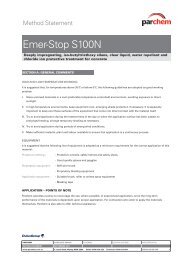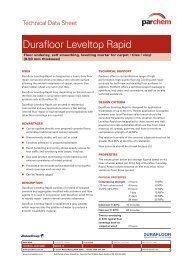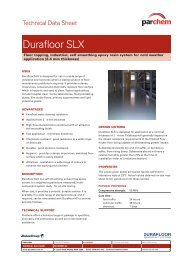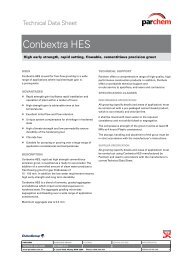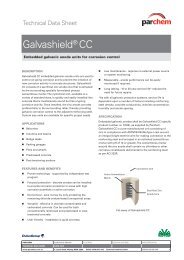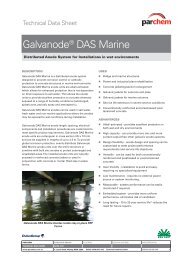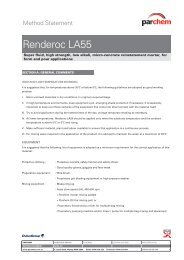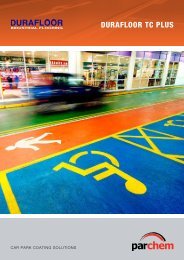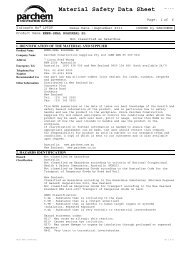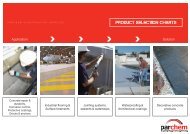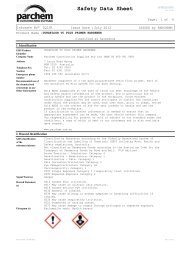emer-aquashield base sds - Parchem
emer-aquashield base sds - Parchem
emer-aquashield base sds - Parchem
Create successful ePaper yourself
Turn your PDF publications into a flip-book with our unique Google optimized e-Paper software.
Material Safety Data SheetCS: 1.4.51Page: 1of4Infosafe No LPTB6 Issue Date : August 2009 ISSUED by PARCHEMCProduct Name EMER-AQUASHIELD BASE1. IDENTIFICATION OF THE MATERIAL AND SUPPLIERProduct Name EMER-AQUASHIELD BASECompany Name <strong>Parchem</strong> Construction Supplies Pty Ltd (ABN 80 069 961 968)Address7 Lucca Road WyongNSW 2259 AustraliaEmergency Tel. 1800 638 556 (available 24/7)Telephone/Fax Tel: 02 4350 5000NumberFax: 02 4351 2024Recommended Use Base of two part water-<strong>base</strong>d epoxy coating.Other Information This MSDS summarises at the date of issue our best knowledge of the health andsafety hazard information of the product, and in particular how to safelyhandle and use the product in the workplace. Since <strong>Parchem</strong> ConstructionSupplies Pty Ltd cannot anticipate or control the conditions under which theproduct may be used, each user must, prior to usage, review this MSDS in thecontext of how the user intends to handle and use the product in theworkplace.If clarification or further information is needed to ensure that anappropriate assessment can be made, the user should contact this company.Our responsibility for product as sold is subject to our standard terms andconditions, a copy of which is sent to our customers and is also availableupon request.www.parchem.com.au2. HAZARDS IDENTIFICATIONHazardClassificationRisk Phrase(s)Safety Phrase(s)Classified as Hazardous according to criteria of National Occupational Health& Safety Commission (NOHSC), Australia.Not classified as Dangerous Goods according to the Australian Code for theTransport of Dangerous Goods by Road and Rail (ADG Code).R36 Irritating to eyes.S24/25 Avoid contact with skin and eyes.S26 In case of contact with eyes, rinse immediately with plenty of water andseek medical advice.S37/39 Wear suitable gloves and eye/face protection.3. COMPOSITION/INFORMATION ON INGREDIENTSIngredientsNameCASPolyaminoamideProprietaryadductIngredientsdetermined not tobe hazardousProportion1-
Material Safety Data SheetCS: 1.4.51Page: 2of4Infosafe No LPTB6 Issue Date : August 2009 ISSUED by PARCHEMCProduct Name EMER-AQUASHIELD BASE5. FIRE FIGHTING MEASURESSuitableUse water spray, foam, carbon dioxide or dry chemical to extinguish fire. UseExtinguishing Media water spray to cool containers and fire-exposed surfaces.Hazards from Combustion products include oxides of carbon. Under fire conditions thisCombustion product may emit toxic and/or irritating fumes, smoke and gases includingProductscarbon monoxide and carbon dioxide.Specific Hazards The product is not combustible, but under fire conditions, the organicPrecautions inconnection with Firecomponents may decompose and/or burn after the water component evaporates.Fire fighters should wear Self-Contained Breathing Apparatus (SCBA) and fullprotective clothing to prevent exposure to vapours, fumes or products ofcombustion. Water spray may be used to cool down heat-exposed containers.6. ACCIDENTAL RELEASE MEASURESEmergencyProcedures7. HANDLING AND STORAGEPrecautions for SafeHandlingConditions for SafeStorageWear protective clothing and equipment to prevent exposure. Extinguish orremove all sources of ignition and stop leak if safe to do so. The floors maybe slippery. Remove unprotected personnel. If possible contain the spill.Place inert, non-combustible absorbent such as sand onto material. Prevent runoff into drains and waterways. Use clean non-sparking tools to collect thematerial and place into suitable, labelled containers. If contamination ofsewers or waterways occurs inform the local water authorities and EPA inaccordance with local regulations. Dispose of waste according to applicablelocal and national regulations.Avoid contact with skin and eyes. Wear overalls, impervious gloves and safetyglasses. Use only in well ventilated areas. Avoid breathing vapour or spraymist. Keep containers closed when not in use. Do not empty into drains.Maintain a high level of personal hygiene when using the product, that is,always wash hands after handling, and before eating, drinking, smoking orusing the toilet facilities.Store in a cool, dry, well ventilated area away from sources of ignition,oxidising agents, foodstuffs, clothing and out of direct sunlight. Keepcontainers closed when not in use and securely sealed and protected againstphysical damage. Inspect regularly for deficiencies such as damage or leaks.Have appropriate fire extinguishers available in and near the storage area.8. EXPOSURE CONTROLS/PERSONAL PROTECTIONNational ExposureStandardsBiological LimitValuesEngineeringControlsRespiratoryProtectionEye ProtectionHand ProtectionNo exposure standards have been established for this substance by the NationalOccupational Health & Safety Commission (NOHSC), Australia. However,over-exposure to some chemicals may result in adverse effects on health oraggravation of pre-existing adverse medical conditions and/or allergicreactions and should be kept to the lowest possible levels.No biological limit allocated.Provide sufficient ventilation. Where vapours or mists are generated,particularly in enclosed areas, and natural ventilation is inadequate, a localexhaust ventilation system is required.If engineering controls are not effective in controlling airborne exposurethen an approved respirator with an organic vapour/mist filter should be used.Reference should be made to Australian Standards AS/NZS 1715, Selection, Useand Maintenance of Respiratory Protective Devices; and AS/NZS 1716,Respiratory Protective Devices, in order to make any necessary changes forindividual circumstances.Safety glasses with side shields or safety goggles as appropriate recommended.Final choice of appropriate eye/face protection will vary according toindividual circumstances ie. methods of handling or engineering controls andaccording to risk assessments undertaken. Eye protection should conform withAustralian/New Zealand Standard AS/NZS 1337- Eye Protectors for IndustrialApplications.Wear laminated film, nitrile, neoprene or other suitable, impervious gloves.Final choice of appropriate gloves will vary according to individualcircumstances i.e. methods of handling or according to risk assessmentsundertaken. Reference should be made to AS/NZS 2161.1: Occupational protectivePrint Date: 25/08/2009 CS: 1.4.51
Material Safety Data SheetCS: 1.4.51Page: 3of4Infosafe No LPTB6 Issue Date : August 2009 ISSUED by PARCHEMCProduct Name EMER-AQUASHIELD BASEgloves - Selection, use and maintenance.Body Protection Suitable protective workwear, e.g. cotton overalls buttoned at neck and wrist.When large quantities are handled the use of plastic aprons and rubber bootsis recommended. Industrial clothing should conform to the specificationsdetailed in AS/NZS 2919: Industrial clothing.9. PHYSICAL AND CHEMICAL PROPERTIESAppearance White liquid.OdourCharacteristic mild odour.Melting Point Not availableBoiling Point 100°C (initial)Solubility in Water SolubleSpecific Gravity 1.64 at 23°CpH ValueNot availableVapour Pressure Not availableVapour Density >1(Air=1)Evaporation Rate
Material Safety Data SheetCS: 1.4.51Page: 4of4Infosafe No LPTB6 Issue Date : August 2009 ISSUED by PARCHEMCProduct Name EMER-AQUASHIELD BASEMobilityBioaccumulativePotentialEnviron. ProtectionAcute Toxicity - FishNot availableNot availableDo not contaminate waterways.Not available13. DISPOSAL CONSIDERATIONSDisposalConsiderations14. TRANSPORT INFORMATIONTransportInformationDispose of waste according to Environmental Protection Authority, federal,state and local regulations.Road and Rail Transport (ADG Code):Not classified as Dangerous Goods according to the Australian Code for theTransport of Dangerous Goods by Road and Rail (ADG Code).Marine Transport (IMO/IMDG):Not classified as Dangerous Goods by the criteria of the InternationalMaritime Dangerous Goods Code (IMDG Code) for transport by sea.Air Transport (ICAO/IATA):Not classified as Dangerous Goods by the criteria of the International AirTransport Association (IATA) Dangerous Goods Regulations for transport by air.15. REGULATORY INFORMATIONRegulatoryInformationPoisons ScheduleHazard CategoryAICS (Australia)Classified as Hazardous according to criteria of National Occupational Health& Safety Commission (NOHSC), Australia.Not classified as a Scheduled Poison according to the Standard for the UniformScheduling of Drugs and Poisons (SUSDP).Not ScheduledIrritant16. OTHER INFORMATIONDate of preparationor last revision ofMSDSContactPerson/PointAll components of this product are listed on the Australian Inventory ofChemical Substances (AICS), or otherwise are in compliance with the NICNASrequirements.MSDS Reviewed: August 20009Supersedes: September 2004Technical Support: 1800 812 864...End Of MSDS...© Copyright ACOHS Pty LtdCopyright in the source code of the HTML, PDF, XML, XFO and any other electronic files rendered by an Infosafe system for Infosafe MSDS displayed is the intellectualproperty of Acohs Pty Ltd.Copyright in the layout, presentation and appearance of each Infosafe MSDS displayed is the intellectual property of Acohs Pty Ltd.The compilation of MSDS's displayed is the intellectual property of Acohs Pty Ltd.Copying of any MSDS displayed is permitted for personal use only and otherwise is not permitted. In particular the MSDS's displayed cannot be copied for the purpose ofsale or licence or for inclusion as part of a collection of MSDS without the express written consent of Acohs Pty Ltd.Print Date: 25/08/2009 CS: 1.4.51



